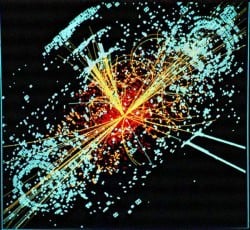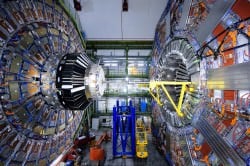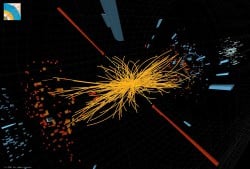[embed]
What is this thing we keep hearing about - the Higgs Boson, and why is it important?
It's been said that the best way to learn is to teach. And so, today I'm going to explain everything I can about the Higgs boson. And if I do this right, maybe, just maybe, I'll understand it a little better by the end of the episode.
I'd like to be clear that this video is for the person whose eyes glaze over every time you hear the term Higgs boson. You know it's some kind of particle, Nobel prize, mass, blah blah. But you don't really get what it is and why it's important.
First, let's start with the Standard Model. These are essentially the laws of particle physics as scientists understand them. They explain all the matter and forces we see all around us. Well, most of the matter, there are a few big mysteries, which we'll discuss as we get deeper into this.
But the important thing to understand is that there are two major categories: the fermions and the bosons.
[caption id="attachment_82866" align="alignleft" width="250"]
Bosons, fermions and other particles after a collsion. Credit: CERN[/caption]
Fermions are matter. There are the protons and neutrons which are made up of quarks, and there are the leptons, which are indivisible, like electrons and neutrinos. With me so far? Everything you can touch are these fermions.
The bosons are the particles that communicate the forces of the Universe. The one you're probably familiar with is the photon, which communicates the electromagnetic force. Then there's the gluon, which communicates the strong nuclear force and the W and Z bosons which communicate the weak nuclear force.
Mystery number 1, gravity. Although it's one of the fundamental forces of the Universe, nobody has discovered a boson particle that communicates this force. So, if you're looking for a Nobel Prize, find a gravity boson and it's yours. Prove that gravity doesn't have a boson, and you can also get a Nobel Prize. Either way, there's a Nobel Prize in it for you.
[caption id="attachment_123892" align="alignright" width="250"]
Credit: PBS NOVA [1], Fermilab, Office of Science, United States Department of Energy, Particle Data Group[/caption]
Again, this is the Standard Model, and it accurately describes the laws of nature as we see them around us.
One of the biggest unsolved mysteries in physics was the concept of mass. Why does anything have mass at all, or inertia? Why does the amount of physical "stuff" in an object define how easy it is to get moving, or how hard it is to make it stop?
In the 1960s, physicist Peter Higgs predicted that there must be some kind of field that permeates all of space and interacts with matter, sort of like a fish swimming through water. The more mass an object has, the more it interacts with this Higgs field.
And just like the other fundamental forces in the Universe, the Higgs field should have a corresponding boson to communicate the force - this is the Higgs boson.
The field itself is undetectable, but if you could somehow detect the corresponding Higgs particles, you could assume the existence of the field.
[caption id="attachment_116493" align="alignleft" width="250"]
Cross-section of the Large Hadron Collider where its detectors are placed and collisions occur. LHC is as much as 175 meters (574 ft) below ground on the Frence-Swiss border near Geneva, Switzerland. The accelerator ring is 27 km (17 miles) in circumference. (Photo Credit: CERN)[/caption]
And this is where the Large Hadron Collider comes in. The job of a particle accelerator is to convert energy into matter, via the formula e=mc2. By accelerating particles - like protons - to huge velocities, they give them an enormous amount of kinetic energy. In fact, in its current configuration, the LHC moves protons to 0.999999991c, which is about 10 km/h slower than the speed of light.
When beams of particles moving in opposite directions are crashed together, it concentrates an enormous amount of energy into a tiny volume of space. This energy needs somewhere to go so it freezes out as matter (thanks Einstein). The more energy you can collide, the more massive particles you can create.
And so, in 2013, the LHC allowed physicists to finally be able to confirm the presence of the Higgs Boson by tuning the energy of the collisions to exactly the right level, and then detecting the cascade of particles that occur when Higgs bosons decay.
Because the right particles are detected, you can assume the presence of the Higgs boson, and because of this, you can assume the presence of the Higgs field. Nobel prizes for everyone.
[caption id="attachment_127089" align="alignright" width="250"]
Particle collision. Credit: CERN[/caption]
I said there were a few mysteries left; gravity was one, of course, but there are a few more. The reality is that physicists now know that the matter I described is really just a fraction of the entire Universe. Cosmologists estimate that just 4% of the Universe is the normal baryonic matter that we're familiar with.
Another 23% is dark matter, and a further 73% is dark energy. So there are still plenty of mysteries to keep physicists busy for years.
And so, in 2013, the Large Hadron Collider finally turned up the particle that physicists had predicted for 50 years. The last piece of the Standard Model was finally proven to exist, and we're closer to understanding what 4% of the Universe is. The other 96% (oh, and gravity), are still a total mystery.
Physicists are cranking up the LHC to higher and higher levels of energy, to search for other particles, to understand dark matter, and see if they can generate microscopic black holes. This mighty instrument has plenty more science to reveal, so stay tuned.
That's the Higgs Boson in a nutshell. Let me me know if there are other concepts in particle physics you'd like to talk about. Put your ideas into the comments below.
 Universe Today
Universe Today


![Credit: PBS NOVA [1], Fermilab, Office of Science, United States Department of Energy, Particle Data Group](/article_images/Standard_Model_of_Elementary_Particles.svg_-250x188.png)

